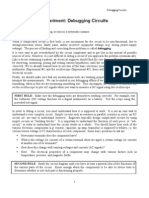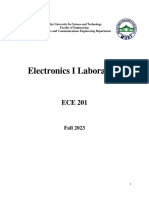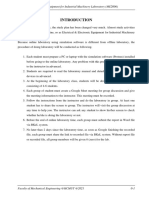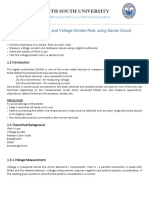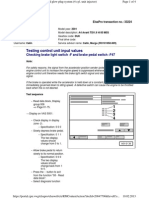Lab 1 Introduction
Lab 1 Introduction
Uploaded by
safdarmunir070Copyright:
Available Formats
Lab 1 Introduction
Lab 1 Introduction
Uploaded by
safdarmunir070Copyright
Available Formats
Share this document
Did you find this document useful?
Is this content inappropriate?
Copyright:
Available Formats
Lab 1 Introduction
Lab 1 Introduction
Uploaded by
safdarmunir070Copyright:
Available Formats
Sir Syed CASE Institute of Technology, Islamabad
EE2401 Digital Logic Design
Lab No. 1
Name of Student: Roll No. :
Date of Experiment: Report submitted on:
Marks obtained: Instructor’s Signature:
Instructor: Engr Safdar Munir
Familiarization With Digital Logic Design, Digital Trainer, Bread
Board, Basic Electric Circuits
Objectives
The goal of this lab is to teach students how to use laboratory equipments, perform procedures
and learn proper techniques of DLD. The student should become familiar with the complete
Electronics Trainers, Bread board, Digital Multimeter (DMM), and laboratory accessories such
as wires, integrated circuits, electronic components and tools.
1. Integrated Circuits
Some Gate ICs and there part numbers
2. Breadboard:
A breadboard is a solder less device for temporary prototype with electronics and test
circuit designs. Most electronics components in electronic circuits can be interconnected
by inserting their leads or terminals into the holes and then making connections through
wires where ever required. The breadboard has strips of metal underneath the board that
connect the holes on the top of the board. The metal strips are laid out as shown below.
Note that the top and bottom rows of holes are connected horizontally and split in the
middle while the remaining holes are connected vertically.
Note how all holes in the selected row are connected, so the holes in the selected column.
The set of connected holes can be called a node:
Digital Logic Design Lab (EE-2401) 2
To interconnect the selected row (node A) and column (node B) a cable going from any
hole in the row to any hole in the column is needed:
Connecting components into Breadboard:
Digital Logic Design Lab (EE-2401) 3
Making a good circuit:
While connecting components into the circuit you have to keep following things in mind.
1. The arrangement of the wires should be neat and clean.
2. Try to connect wires in such a way that no wire should be passing over the ICs in the
circuit.
3. The ICs in the circuitry should be connected keeping in mind that no two legs should
get short by each other.
4. Try to make one common point for the Vcc and Ground connections.
3. Electronic Trainer:
Electronic trainer is designed for the
logic beginners to enhance the
comprehension of basic logical theory.
The design of trainer is easy to operate
and easy to understand. It is equipped
with various kinds of logical switches,
LED indicators, DC power supply with
short circuit protection, pulse generator,
internal dc power supplies and solder
less breadboard.
Safety Precautions for using the Electronic Trainer:
1. The Vcc and the ground of the trainer should not get connected (short) by any
mean otherwise the trainer will automatically turn off.
2. Try to handle the switches of the trainer carefully, as they may get damaged by
misuse.
4. Digital Multimeter (DMM):
A multimeter is an instrument used to check for AC or DC
voltages, resistance or continuity of electrical components and
small amounts of current in circuits. This instrument will let
you check to see if there is voltage present on a circuit, etc. In
addition it can check certain electronic devices like transistors,
diode/LEDs etc.
Voltage Measurement:
Certain precautions are taken while using DMM for measuring
voltages
1) The DMM must be set to desired range while measuring voltage e.g if we want to
measure voltage upto 20V then the dial (selector) should not be on 10V, it should be
on 20V or above.
2) Voltage is always measured across two points.
Digital Logic Design Lab (EE-2401) 4
3) Appropriate settings to be selected when measuring AC or DC voltage. To measure
DC voltage the selector should be at DCV and while measuring AC voltage the
selector should be at ACV.
Resistance Measurement:
The meter dial should be pointing towards resistance measurement in this case. The
appropriate range also needs to be selected.
Please make sure that during this condition, the probes of the DMM should not touch
each other when the instrument is not in use. Doing so will drain the battery of DMM in
just a few hours.
Short Circuit Test:
This test is usually done in order to check the connectivity of different electrical circuits.
Turn the knob of the DMM towards the short circuit test (Icon showing diode shape).
Now the DMM is ready for a short test.
If you touch both the probes (red and black) of the DMM with each other, you will be
able to hear a beep (sound) which shows that the path is short. Similarly in order to check
any connection in the circuit, you can use the short test to verify that the circuit is
complete.
Digital Logic Design Lab (EE-2401) 5
5. LED
A light-emitting diode (LED) is a semiconductor
light source. LEDs are used as indicator lamps in
many devices and are increasingly used for
general lighting
Single color LED
RGB Led
6. Resistor
Resistors are the most used component in electronics and their purpose is to create
specified values of current and voltage in a circuit.
Digital Logic Design Lab (EE-2401) 6
7. IC Tester
8. Switch
SPDT Switch DIP Switch push Button
Digital Logic Design Lab (EE-2401) 7
Lab Task
1. Measure the voltage of lab trainer.
2. Measure the AC Voltage
3. Find the resistance of given circuit
4. Design the given circuit
Digital Logic Design Lab (EE-2401) 8
You might also like
- BEE Complete Manual (EC102)Document48 pagesBEE Complete Manual (EC102)Vinit VikasNo ratings yet
- Activity 1.1.5b Circuit Theory: SimulationDocument4 pagesActivity 1.1.5b Circuit Theory: SimulationParkerNo ratings yet
- DLD Lab Manual 01Document6 pagesDLD Lab Manual 01Sana gullNo ratings yet
- Digital Logic Design: Laboratory ManualDocument7 pagesDigital Logic Design: Laboratory ManualLovely Jutt0% (1)
- Electronics Assignment 1-MergedDocument9 pagesElectronics Assignment 1-MergedTyrion LannisterNo ratings yet
- DLD Lab1 StmuDocument17 pagesDLD Lab1 Stmuhassan aliNo ratings yet
- Epl Lab ManualDocument24 pagesEpl Lab ManualselciyaskylarNo ratings yet
- Lab0 EE PDFDocument16 pagesLab0 EE PDFAbdullah AL MA'MUNNo ratings yet
- Lab0 EE PDFDocument16 pagesLab0 EE PDFAbdullah AL MA'MUNNo ratings yet
- Digital 1 Lab - 2023Document60 pagesDigital 1 Lab - 2023Emmanuel OloyedeNo ratings yet
- Practical No:-1: Know The Digital Lab IC Tester Multimeter Bread Board Trainer KitDocument16 pagesPractical No:-1: Know The Digital Lab IC Tester Multimeter Bread Board Trainer KitH123 Thawal GauravNo ratings yet
- Workshop Training Manual COURSE: WS1020: Central Workshop Indian Institute of Technology Madras CHENNAI - 600036, INDIADocument44 pagesWorkshop Training Manual COURSE: WS1020: Central Workshop Indian Institute of Technology Madras CHENNAI - 600036, INDIAhariharanhemanthNo ratings yet
- Expt No 1 Electronic Components and ConnectionsDocument6 pagesExpt No 1 Electronic Components and ConnectionsVaibhav24k PanchalNo ratings yet
- WS 1020Document44 pagesWS 1020Sunil Sree NathNo ratings yet
- Exp 1 Multimeter, Breadboard and Power Supply (2012)Document14 pagesExp 1 Multimeter, Breadboard and Power Supply (2012)usmpowerlab50% (2)
- Lab ArduinoDocument16 pagesLab Arduinoadib haikalNo ratings yet
- Asmt Bene3143 Sem 1 2021-2022 - RevisedDocument8 pagesAsmt Bene3143 Sem 1 2021-2022 - RevisedFarah SyuhanaNo ratings yet
- DAC CompleteDocument9 pagesDAC CompleteNashrul HaqNo ratings yet
- EP Manual Master Final 31-01-11Document102 pagesEP Manual Master Final 31-01-11birenNo ratings yet
- Lab 01-Lab Equipment IntroductionDocument5 pagesLab 01-Lab Equipment IntroductionAbraizNo ratings yet
- Experiment: Debugging Circuits: I. ObjectiveDocument5 pagesExperiment: Debugging Circuits: I. ObjectiveArun UpadhyayaNo ratings yet
- IntroductionDocument19 pagesIntroductionjolo cunananNo ratings yet
- DLD Lab ManualDocument15 pagesDLD Lab ManualReal ManNo ratings yet
- Testing StrategiesDocument8 pagesTesting StrategiesJohnny Pancito Rodriguez100% (1)
- WorkshopDocument30 pagesWorkshopDarshan JainNo ratings yet
- Intriduction To Lab EquipmentDocument3 pagesIntriduction To Lab EquipmentBlack Tech100% (1)
- IoT Module 2Document18 pagesIoT Module 2Lujain AmroNo ratings yet
- Slide Bengkel RBT DAY 2Document46 pagesSlide Bengkel RBT DAY 2CHE AMEIR HAMDI BIN CHE YAHYA MoeNo ratings yet
- Short Circuit Detection With ArduinoDocument20 pagesShort Circuit Detection With ArduinoAung MyatNo ratings yet
- Project ReportDocument20 pagesProject Reportsatyendrakumar0927No ratings yet
- EP Manual Master Final 28-01-10 New1Document97 pagesEP Manual Master Final 28-01-10 New1jiyadarjiNo ratings yet
- ITPE-101-Digital-Electronics - Module 1Document25 pagesITPE-101-Digital-Electronics - Module 1Ivan LeeNo ratings yet
- Design and Construction of A Electronics Trainer KitDocument42 pagesDesign and Construction of A Electronics Trainer KitToheebdareNo ratings yet
- Lab Report 2Document6 pagesLab Report 2sharoonahmad359No ratings yet
- Digital Electronics Lab ManualDocument191 pagesDigital Electronics Lab Manuallavanyavinayagam1985100% (1)
- Lab Report 1Document6 pagesLab Report 1sharoonahmad359No ratings yet
- WEEE Lab Manual FinalDocument49 pagesWEEE Lab Manual Finalpm119792No ratings yet
- ESYS1000 Lab 1 - Face To FaceDocument11 pagesESYS1000 Lab 1 - Face To FaceH2 MgZNo ratings yet
- Lab 1 Familiarization With Digital Logic GatesDocument7 pagesLab 1 Familiarization With Digital Logic Gatespioneer boysNo ratings yet
- Cte 242Document11 pagesCte 242olivemarylove732178No ratings yet
- 1.1.2.A Investigating Basic Circuits - DMSDocument9 pages1.1.2.A Investigating Basic Circuits - DMSBilly bobsNo ratings yet
- Salman EsDocument45 pagesSalman EsJourney With MeNo ratings yet
- Department of Software Engineering: Lab1: Familiarization of Basic Gates and Digital IcsDocument14 pagesDepartment of Software Engineering: Lab1: Familiarization of Basic Gates and Digital IcsMuhammad RehanNo ratings yet
- IEEE Paper ProjectDocument6 pagesIEEE Paper Projectchandra1999prasadNo ratings yet
- Lab ManualDocument83 pagesLab ManualLucas EtienneNo ratings yet
- Electronics I Lab. ECE 201Document40 pagesElectronics I Lab. ECE 201ajf3215No ratings yet
- Arduino Report 34Document28 pagesArduino Report 34johnbangsaliwNo ratings yet
- Elc 210 Manual by Adamu MudiDocument35 pagesElc 210 Manual by Adamu MudiAdamu MudiNo ratings yet
- EE-252-Electronic Devices & Digital Electronics Laboratory Manual/ RecordDocument85 pagesEE-252-Electronic Devices & Digital Electronics Laboratory Manual/ RecordkishorebabNo ratings yet
- Report UC 6 7Document83 pagesReport UC 6 7viajoy.demakilingNo ratings yet
- Steps For ProjectDocument2 pagesSteps For Projectpluscommander972No ratings yet
- Electronic Circuit Repair: Electricity and ElectronicsDocument9 pagesElectronic Circuit Repair: Electricity and ElectronicsJames BondNo ratings yet
- ME2006 Online Lab ManualDocument37 pagesME2006 Online Lab ManualNguyễn Nam ViệtNo ratings yet
- Beee Lab Manual-2020Document99 pagesBeee Lab Manual-2020venkata karthikNo ratings yet
- Bài 2,3 Thí Nghiệm Trang Bị ĐiệnDocument37 pagesBài 2,3 Thí Nghiệm Trang Bị ĐiệnNguyen TrongNo ratings yet
- Submitted To: A Practical Activity Report Submitted For Engineering Design Project-II (UTA-014) byDocument4 pagesSubmitted To: A Practical Activity Report Submitted For Engineering Design Project-II (UTA-014) bySimranjeet SinghNo ratings yet
- EEE 141 Lab ManualsDocument45 pagesEEE 141 Lab Manualsjazz popNo ratings yet
- North South University: Lab 1: Ohm's Law, KVL, and Voltage Divider Rule Using Series CircuitDocument12 pagesNorth South University: Lab 1: Ohm's Law, KVL, and Voltage Divider Rule Using Series CircuitNazmul Hasan 1911742042No ratings yet
- Arduino Measurements in Science: Advanced Techniques and Data ProjectsFrom EverandArduino Measurements in Science: Advanced Techniques and Data ProjectsNo ratings yet
- Lab 10 Mux & DeMuxDocument9 pagesLab 10 Mux & DeMuxsafdarmunir070No ratings yet
- Lab 9 Encoders and DecodersDocument7 pagesLab 9 Encoders and Decoderssafdarmunir070No ratings yet
- Lab 7 Half & Full AdderDocument8 pagesLab 7 Half & Full Addersafdarmunir070No ratings yet
- Lab 4 Verilog Gate Level ModellingDocument11 pagesLab 4 Verilog Gate Level Modellingsafdarmunir070No ratings yet
- 5700BHRFBC Specifications: - Canopy PTP 100 SeriesDocument1 page5700BHRFBC Specifications: - Canopy PTP 100 SeriesperuingenierosNo ratings yet
- Technical Section About Jtag For Newbies PDFDocument9 pagesTechnical Section About Jtag For Newbies PDFEdenia JolvinoNo ratings yet
- Datavideo MCU-100PDocument22 pagesDatavideo MCU-100PTomas VeteveNo ratings yet
- Watkins-Johnson Topology Integrated in A Full-Bridge ConverterDocument7 pagesWatkins-Johnson Topology Integrated in A Full-Bridge Converterelpatotas22No ratings yet
- Phase Sequence Meter PrincipleDocument5 pagesPhase Sequence Meter Principlehasbi fadliNo ratings yet
- TC-P42X1: 42 Inch Class 720p Plasma HDTVDocument108 pagesTC-P42X1: 42 Inch Class 720p Plasma HDTVGeovanny SanJuanNo ratings yet
- Beng (Hons) Telecommunications: Cohort: Btel/10B/Ft & Btel/09/FtDocument9 pagesBeng (Hons) Telecommunications: Cohort: Btel/10B/Ft & Btel/09/FtMarcelo BaptistaNo ratings yet
- CAL291 Manual I291.01 (B)Document23 pagesCAL291 Manual I291.01 (B)Lizbeth Paulina Montalvo ButronNo ratings yet
- Pioneer Deh p4950mpDocument68 pagesPioneer Deh p4950mpGauravSinghNo ratings yet
- Low-Power Analog IC Design Activities at CNM: Justo SabadellDocument31 pagesLow-Power Analog IC Design Activities at CNM: Justo SabadellicdaneNo ratings yet
- Lab Report CS 11Document4 pagesLab Report CS 11ubaidNo ratings yet
- Osisense XX Xx630a1pcm12Document2 pagesOsisense XX Xx630a1pcm12nvkjayanthNo ratings yet
- 2018 Sachdeva Kumar Mishra Digital Video EditingDocument102 pages2018 Sachdeva Kumar Mishra Digital Video Editingmaneesh sNo ratings yet
- Megger ManualDocument84 pagesMegger ManualJackson Dias RochaNo ratings yet
- Silicon Power Transistor: Data SheetDocument5 pagesSilicon Power Transistor: Data Sheetibnu2malkanNo ratings yet
- Advanced Electronic Protection System To Prevent Exam Paper LeakagesDocument135 pagesAdvanced Electronic Protection System To Prevent Exam Paper LeakagesSyed Viquar AhmedNo ratings yet
- XGT Series - Catalog - EN (20) 202004 PDFDocument148 pagesXGT Series - Catalog - EN (20) 202004 PDFEkanit ChuaykoedNo ratings yet
- Arbily TWS-i7 ManualManualDocument1 pageArbily TWS-i7 ManualManualmassimodinelliNo ratings yet
- LTN154BT02 001 SamsungDocument26 pagesLTN154BT02 001 SamsungClément SaillantNo ratings yet
- Embedded Systems and Model of Metro TrainDocument35 pagesEmbedded Systems and Model of Metro TrainSantosh Singh Chauhan100% (20)
- Chap2 - Transceiver Architectures IDocument30 pagesChap2 - Transceiver Architectures ILong Lê Văn100% (1)
- Intrerupator Pedala Frana PDFDocument4 pagesIntrerupator Pedala Frana PDFaritmeticsNo ratings yet
- Delta Ia-Plc Tp04g-Al I Tse 20220906Document24 pagesDelta Ia-Plc Tp04g-Al I Tse 20220906WilliamsNo ratings yet
- Jabra Speak 510 User Manual - EN RevFDocument21 pagesJabra Speak 510 User Manual - EN RevFcsudhaNo ratings yet
- SAP-1 Simple As Possible Computer Schematic Diagram - Updated DesignDocument1 pageSAP-1 Simple As Possible Computer Schematic Diagram - Updated Designpong74lsNo ratings yet
- Weighing Indicator Serie Ipe 50: Short Guide For Calibration OnlyDocument16 pagesWeighing Indicator Serie Ipe 50: Short Guide For Calibration Onlybona INSTtechnicianNo ratings yet
- Samsung Galaxy Z Flip3 SM F711B 5G - DatasheetDocument3 pagesSamsung Galaxy Z Flip3 SM F711B 5G - DatasheetSasa ArchieNo ratings yet
- RDL-3000 XP Connect Series Short-Form Datasheet 2023-SEP-21Document2 pagesRDL-3000 XP Connect Series Short-Form Datasheet 2023-SEP-21Filipe RangelNo ratings yet
- Ger 4654Document44 pagesGer 4654nooralhuda007No ratings yet
- EST-P1 Promethean Projector - Spec - 9239Document4 pagesEST-P1 Promethean Projector - Spec - 9239XenawiseNo ratings yet




















